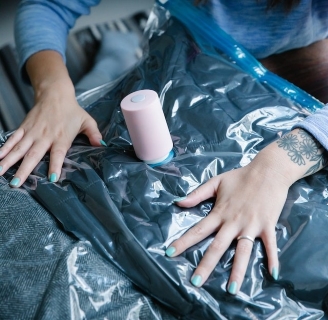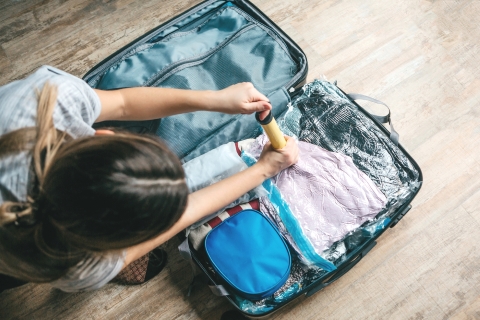Are vacuum sealed bags allowed on planes? This is a question that many travelers have, and the answer is not always straightforward. Different airlines have different rules about what types of luggage are allowed on board, and vacuum sealed bags can sometimes be seen as a security risk. In this article, you’ll get in-depth insights into vacuum sealed bags and whether you can use them while traveling.
Table of Contents
Do Vacuum Bags Work for Packing?
Vacuum bags for clothes travel are designed to remove all the air from whatever you’re packing, whether it’s clothes or other items. This not only frees up space to pack more things, but it also reduces the occurrence of wrinkles because your clothes can’t shift around inside your suitcase.
So, do vacuum bags work for travel packaging? The answer is a resounding yes! You must be aware of the space saver bags that are used with vacuum sealers. You can acquire bags that work in a similar way but are small and adapted for travel without a large vacuum pump.
If you choose regular space saver bags, you’ll be dependent on the availability of a vacuum sealer at your destinations. A much better choice would be specific travel compression bags.
But there are a few things to keep in mind when using vacuum storage bags for travel, however. First, you’ll want to make sure that you have a good seal on the bag. Otherwise, all your hard work will be for nothing. Moreover, you’ll need to have a vacuum sealer that can handle the job. Some are not powerful enough to create a strong seal on the bag. If this is the case, you may want to consider buying a hand-held vacuum sealer.
Some vacuum compression bags come with a built-in vacuum valve, which makes things more convenient. Of course, if saving space in your luggage isn’t a priority, then you may consider packing cubes or even large Ziploc bags instead. Here are the advantages and disadvantages of packing cubes, compression cubes and Ziploc bags for travel.
Plus, you’ll need to be careful about what you pack in the bag. Remember, you’re trying to remove all the air, so anything that’s even remotely fragile or has sharp corners probably shouldn’t go in a vacuum bag.
Here are some of the different types of vacuum bags you can consider using:
Types of Vacuum Packing Bags
Two types of vacuum bags work well, both of which help reduce the space occupied by your garments. They include:
Type 1: Comes With a Hand Pump
Vacuum bags with a hand pump are great for storing clothes, bedding, and even some hard items. They’re great at keeping bottles of toiletries in your checked luggage from leaking because they eliminate the changes in pressure associated with flying. These bags that you take the air out of take up much less space than traditional storage methods, and they keep your belongings free of dust and dirt. Simply place your items in the bag, and seal it shut. The hand pump that comes with the bag is then used to suck out the air so that you have the smallest package of clothes to place in your luggage. This Cozy Essential pack of 20 vacuum storage bags in various sizes include zippers and a hand pump.
Type 2: Roll Up Travel Storage Bags
Roll Up travel storage bags are a great option for storing clothes and other items while traveling. They are made of durable materials and can be rolled up to save space in your luggage. Air is pushed out through the 1-way valve by squeezing and rolling the plastic bag.
These bags can be used to store clothes, towels, blankets, and other soft and pliable items. They are also great for organizing your belongings while on the go. Roll Up travel storage bags are a convenient and simple way to pack your belongings while traveling. This pack of 12 Cozy Essential Roll up Travel Space Savers Bags is ideal for travel without the need of a vacuum pump.
Can You Use Vacuum Bags in Carry-On Luggage?

It’s clearly stated on the Transportation Security Administration’s website that it’s permitted to take vacuum-sealed clothes bags as a carry-on, but they are not encouraged. If something inside it triggers the alarm, it will need to be opened for additional inspection.
One solution is to use a heavy-duty, gallon ziplock freezer bag. If you ever need to open and pull out your belongings at the airport for security reasons, you should be able to pack everything back easily by squeezing out most of the air from it.
Are Vacuum Bags Allowed in Checked Baggage?
While the TSA previously prohibited air suction travel bags in checked baggage, they have since updated their policies. As of October 2017, the Transportation Security Administration (TSA) no longer prohibits vacuum bags in checked baggage. However, they may be subject to additional screening. This means that your bag may need to be opened and inspected by a TSA agent.
Things to Avoid Packing in Compression Bags
While compression bags are most commonly used to pack linens and clothing, they’re capable of storing a variety of soft items. But a few items must be avoided. They include fur, leather, or food items. Items with sharp ridges or corners should also be avoided because they can puncture your vacuum bag.
Conclusion
By now, you should have developed a clear understanding of whether vacuum sealed bags are allowed on planes or not. Not only do you know whether or not you can use them in a carry-on or checked suitcase, you should also understand whether they are good for packing and the different types you could consider buying. We hope that this guide helps you make the right packing decisions and saves you from any troubles at security inspection points at airports.



